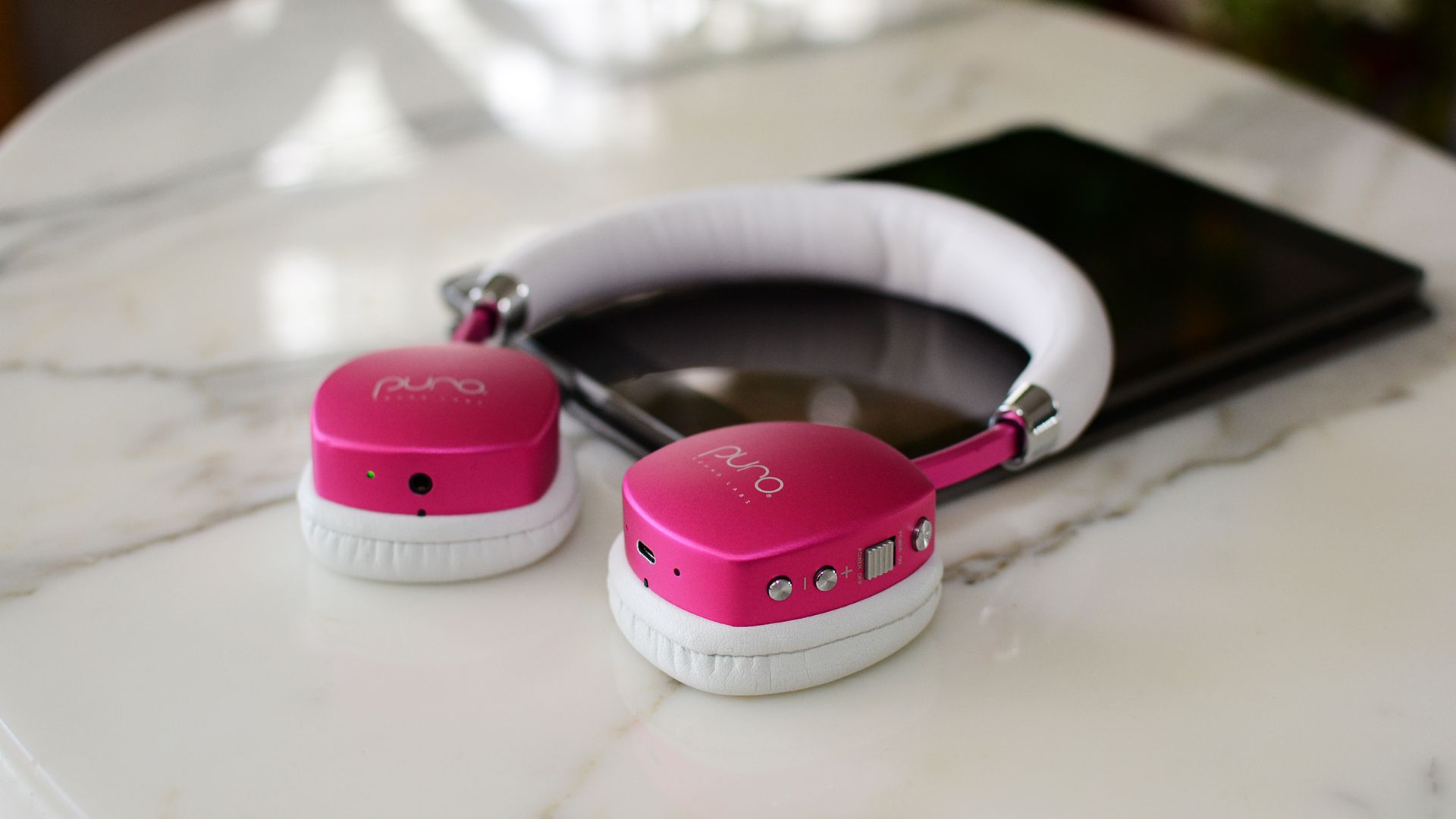Quick Links
Key Takeaways
Many of the devices children use can output sound at levels that will damage their hearing over time. Inexpensive volume-limiting headphones prevent this problem.
Portable devices like tablets, phones, and gaming devices can output sound at a level high enough to damage your hearing. While adults (should!) know better and turn the volume down, kids often don't. Read on as we show you how to protect your kids' hearing with volume-limiting headphones.
Why Should Your Child Use Volume-Limiting Headphones?
Generally, when we think about hearing loss, we think about heavy machinery, a trip to the gun range without proper ear protection, or other loud and immediately painful noises.
But most people don't suffer hearing loss in a catastrophic moment like setting off fireworks in an enclosed space. They suffer hearing loss over time via slow but dangerous exposure to loud noises just loud enough to damage their ears but not loud enough to alarm them. Years of mowing lawns without ear protection, listening to headphones at maximum volume, and attending concerts with skyscraper-sized sound systems contribute to slow, progressive, and irreversible hearing loss.
As adults, we're aware (or should be aware, at any rate) of the risk of damaging our hearing by using power tools without ear protection or cranking up headphones to skull-rattling levels. On the other hand, kids are oblivious to the long-term risk of such exposure.
When you're eight, your baby brother is wailing about something in the car seat next to you, and you really want to hear what the characters in your show are saying, you just turn the volume up on your headphones and get back to enjoying yourself. Kids think nothing of turning the volume up on their personal devices because, if you don't know any better, that's a perfect solution to dealing with external noises invading your listening bubble: turn up the volume until you can't hear those noises anymore. Unfortunately, the upper threshold on most portable devices is well into the danger zone.
The problem of excessively loud and ear-damaging device volume is so widespread, in fact, that European Union regulations limit the output level of portable devices to 85 dB. That's still pretty loud but right on the exact edge of where hearing damage occurs and certainly lower than the previous (and dangerous) 100+ dB upper threshold on older devices like early-gen iPods. That's great if you're in the European Union and you've purchased a new device that adheres to the regulations. But it's not so useful for everyone with older devices or who lives in countries without such regulations.
The best way to protect your child from progressive hearing loss is to equip them with a pair of headphones that limits how loud the volume can go so even when they mash the volume button in response to their loud siblings or a noisy car ride, they can't crank it high enough to hurt themselves.
How Do Volume Limiters and Headphones Work?
Volume limiters come in two forms: whole headphone sets and add-on adapters you insert inline between the headphones and the source device.
The design is extremely simple (and if you're handy with a soldering iron and like DIY solutions, this is something you can even hack together yourself). Volume-limiting devices are just resistors embedded either in the phono plug, on the cable, or inside the pair of headphones.
For those unfamiliar with the guts of electronic devices, the resistor is a little tiny passive electrical component that (as the name implies) creates resistance in a circuit. That resistance lowers the current flow, and by lowering the current flow from the source device to the headphones, the outputted volume is also lowered.
The type of resistor determines the degree of resistance and the degree to which the volume is lowered. While no commercial volume limiters on the market do this, if you made a DIY model, it would be possible to string enough resistors together (or use a beefy enough single resistor) to reduce the volume to inaudible levels. Commercial solutions typically lower the total volume 20-30 percent, which is more than enough to bring the maximum volume of portable devices down into a safer range.
It's a physical change, and short of switching the headphones out with a new pair or removing the adapter, there is no way to sidestep the resistance.
Solving the problem at the headphone level instead of at the device level is preferable, even though some devices have software-based solutions. Apple devices have supported volume limiting for years, for example, and that's great if the only thing your child ever uses their headphones with is their iPad.
But if they unplug the headphones and plug them into anything else, the volume-limiting goes out the window. Giving the child headphones that will limit the volume no matter what device they use is easier and safer.
Where Can I Find Volume Limited Headphones and Adapters?
While you might find volume-limiting headphones here or there in brick-and-mortar stores, your best bet is to shop online. There you'll find a wide variety of volume-limiting headphones and adapters for all needs.
Before we jump into some recommendations, however, let's highlight a few key details so whether you opt for our suggestions or do some poking around on your own you end up with a product that works best for you and your child.
Over-the-Ear Headphones Are Ideal
Although headphones come in all shapes and sizes, we strongly recommend getting over-the-ear closed monitor headphones (as opposed to open-cell headphones) or in-ear earbuds.
Both styles do a much better job of blocking external sound than open-cell headphones. That will, in turn, keep your child from turning the music up louder.
Good closed, over-ear headphones or earbuds significantly block outside noise. That means your child may never even approach the upper threshold of the volume limit in the first place because they hear everything clearly at lower volume levels.
Be Wary of Adjustable Volume-Limiting
If you search through the piles of volume-limiting headphones online, you'll quickly come across models that include a toggle switch for the volume control. The idea is that the lowest setting (85 dB or less) is for younger kids and/or quiet environments, and the higher settings, like 95 dB or even 100+ dB, are for older kids and loud environments.
But whether or not you get hearing damage doesn't depend on your age or the environment you're in. You don't get to skip the damage because you're a middle schooler instead of a toddler or because the airplane was noisy and you just wanted to enjoy your show. Further, the second your kid figures out they can turn the volume up by wiggling a little switch on the headphone cup, the entire volume-limiting headphones effort goes out the window.
So with that in mind, there are solutions for every budget. Let's look at some well-reviewed options in the categories we just highlighted.
Volume-Limiting Over-Ear Closed Headphones
For small children and older kids alike, over-ear closed headphones are our favorite pick. They fit a wide range of children's head/ear sizes, kids that are too small to use in-ear headphones (or find them uncomfortable) can use them easily, and they're far more durable than the much smaller and easily mangled and tangled in-ear headphones.
For the truly wee ones in your life, LilGadgets has a line of volume-limiting headphones that are sized for toddler-to-elementary student-sized heads.
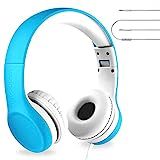
LilGadgets Connect+ Kids Wired Headphones
LilGadgets headphones are sized for children's smaller heads and includes a handy 'SharePort' so a sibling or friend can plug in their headphones too.
They come in a wide range of colors, and they have nice deep comfy ear cups. And they have a really novel feature that helps them stand out among the sea of kid headphones. The feature is called a "SharePort" wherein a sibling or friend can jack their own headphones directly into the LilGadgets headphones and share the listening experience, no additional adapter required.
One thing you'll notice if you test out the audio quality on the cheaper volume-limiting headphones is that it's not amazing. It's completely serviceable for watching YouTube videos and Disney movies on loop, but if your kiddo is a little budding audiophile, you might consider spending more for a proper set of headphones scaled down to child-size for them, like these headphones from Puro Sound Labs.
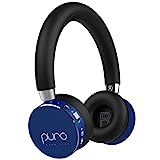
Puro Sound Labs BT2200s Volume Limited Kids' Bluetooth Headphones
They'll run you more than a cheap pair of headphones to be sure, but the audio quality of these Puro headphones is on par with similarly priced adult headphones.
Given that you may end up replacing cheaper headphones multiple times over the years, if you think your child is mature enough to keep track of a more expensive pair and not pack the earcups full of goldfish crackers, it's a worthwhile investment.
There's even a version of the Puro headphones with active noise-cancellation, perfect if you're shopping for a frequent flier who complains they can't hear their tablet over the sound of the airplane engines.
Volume-Limiting Earbuds
For older kids who want lower-profile headphones and are comfortable using earbuds safely, there are a few options to choose from.
LilGadgets, the company that makes the over-ear headphones mentioned above, also makes similarly priced volume-limited earbuds.
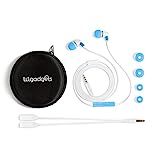
LilGadgets BestBuds
These basic earbuds include in-line volume limiting in a small form factor.
Another company, iFrogz, makes volume-limited earbuds that also come in various colors and themes. It's worth noting that the market for volume-limited earbuds is very small. You may wish to purchase a pair of regular earbuds and use a volume-limiting headphone adapter (which we'll talk about in the next section).
Volume-Limiting Headphone Adapters
In addition to buying dedicated volume-limiting headphones and earbuds, there's a universal solution for any headphones that allows you to use any wired headphones on the market.
Volume-limiting headphones are just headphones that have the resistor built into the headphones unit or the existing cord. A volume-limiting headphone adapter simply acts as a very short extension to your existing headphone cable and features an in-line resistor built into the adapter. Slap it in between your device and the headphones, and the volume is immediately limited.
In the case of the popular Kidz Gear single limiting cable and split limiting cable, the adapter cable limits the original volume to 80 percent of the maximum output.
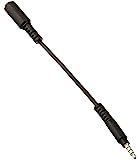
Kidz Gear Volume Limit Cable
This simple headphone cable extension will automatically lower the volume of any connected headphones to 80% of the previous maximum output.
One problem with the adapter system is that if you've got a clever kid on your hands who figures out that the little extension you've added to the headphones is the source of the suddenly quieter experience, they can just unplug it and go back to using the old headphones at ear-blasting volumes.
With older kids, you can discuss how hearing damage is cumulative and lasting, and they need to take care of their ears. With younger kids, we'd recommend purchasing some heat-shrink tubing and making a semi-permanent seal between the adapter and the headphones by sealing it together with the tubing. You can always remove it later with a razor, but there's no risk of a toddler undoing your handiwork.
While a serious talk about treating your ears with kindness for a lifetime of good hearing is an important conversation, kids will be kids---and a little preventative action on your behalf will ensure their hearing is protected when they're too young to make smart choices and protect it themselves.

